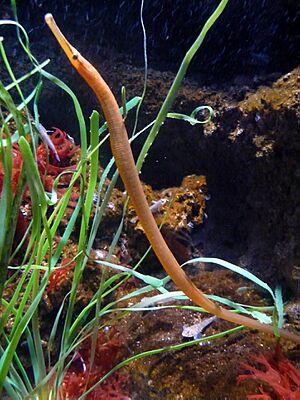Snake pipefish facts for kids
Quick facts for kids Snake pipefish |
|
|---|---|
 |
|
| Conservation status | |
| Scientific classification | |
| Genus: |
Entelurus
|
| Species: |
aequoreus
|
| Synonyms | |
|
Syngnathus aequoreus Linnaeus, 1758 |
|
The snake pipefish (Entelurus aequoreus) is a cool type of pipefish that looks a lot like a snake! It belongs to the family called Syngnathidae, which also includes seahorses. These fish live in the northeastern Atlantic Ocean, usually hiding among algae close to the shore. It's the biggest pipefish found in European waters. In the early 2000s, it even started moving into colder arctic waters!
Contents
Description
What Does It Look Like?
The snake pipefish has a very long, thin body that feels smooth. It's different from other pipefish because it hardly has any bony rings on its body. It has a long head with a thin dark stripe on its sides. Its snout is long and curved, and its mouth is very small and can stick out to grab food.
This fish has a long fin on its back called a dorsal fin, with many short rays. Its tail fin, called a caudal fin, is tiny. Interestingly, it doesn't have pectoral fins (like arms) or anal fins (near the tail underneath).
Colors and Size
Snake pipefish are usually pale brown or yellowish-green. Each of the 28 to 31 rings on their body has pale blue rings with dark edges. The opening to their gills is just a small hole above their opercle (gill cover).
Males can grow up to 40 cm (about 16 inches) long. Females can get even bigger, up to 60 cm (about 24 inches). However, they are more often found around 32 cm (12.5 inches) for males and 45 cm (17.5 inches) for females. Young pipefish, less than 70 mm (2.7 inches) long, have small pectoral fins, but these disappear as they grow up.
Distribution
Where Do They Live?
The snake pipefish lives in the northeastern Atlantic Ocean. You can find them from Iceland and Norway all the way down to the Azores islands. They also live in the Baltic Sea.
In the early 2000s, these fish started to spread even further north. They reached places like Svalbard and the Barents Sea. However, you won't find them in the Mediterranean Sea.
Habitat and Life Cycle
Where They Hang Out
Snake pipefish often live in deeper, more open waters than other pipefish species. They can be found at depths from 10 to 100 meters (about 33 to 330 feet). They like to hide among kelp and other deep-water seaweeds, as well as sea grass like Zostera marina. Some young and adult pipefish have also been seen swimming in the open ocean, far from the bottom.
Their color and patterns help them blend in perfectly with their surroundings. This is called camouflage. An invasive Japanese seaweed called Sargassum muticum has spread in some areas, like the Waddensee sand flats. This has actually helped the snake pipefish population grow there.
Reproduction and Diet
Snake pipefish usually breed in the middle of summer. The male and female fish pair up. They are ovoviviparous, which means the eggs hatch inside the mother, but the young develop in a special way on the father. The female attaches over 1,000 fertilized eggs to a sticky layer of mucus on the male's belly. Each egg is tiny, about 1.2 mm (0.05 inches) wide. The male carries the eggs until they hatch.
After they hatch, the baby fish (called fry) swim in the open ocean until they are about 12 mm (0.5 inches) long. Adult snake pipefish eat small crustaceans (like tiny crabs or shrimp) and baby fish. They catch their food by sucking it into their small mouths.
A Challenge for Seabirds
In the 2000s, when snake pipefish numbers grew, some seabirds started trying to eat them. Birds like auks and terns tried to feed these pipefish to their chicks. This happened because their usual food, sand-eels, had become harder to find.
However, pipefish are not very nutritious compared to oily sand-eels. Also, their bodies are quite bony and hard to digest. Many young birds even choked on them. It was a tough lesson for the birds about what makes a good meal!


